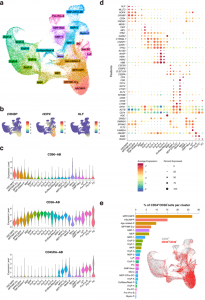The human body produces roughly five million new blood cells every second, making the blood system one of the most regenerative organs. These cells originate from hematopoietic stem cells (HSCs) in the bone marrow, which give rise to everything from red blood cells and platelets to the white blood cells responsible for immune defence. This tightly controlled differentiation process must maintain a careful balance across all blood cell types. If disrupted, the consequences can range from immunodeficiency to blood cancers like leukemia.
In a new study, researchers have uncovered an unexpected immune-regulatory role for blood stem cells, a finding that could reshape how stem cell transplants are approached in the treatment of leukemia and other blood-related conditions (Figure 1). They reveal that even the earliest blood stem cells express a protein called PD-L2—a molecule known to suppress immune activation. This suggests that stem cells may actively protect themselves from immune attack, particularly from T cells, the immune system’s potent responders.

Figure 1: Single cell transcriptomic/AbSeq profiling of CD34+cells from human BM. a UMAP visualization of gene expression-based clustering analysis of 62,277 CD34+ cells from 15 donors with cluster annotation. b Feature plots for the expression of human stem cell gene markers. c Violin plots showing the surface protein expression of CD90, CD38 and CD45RA, detected by Transcriptomic/AbSeq. d Dot-plot visualization of gene expression of previously defined cell type-specific markers. e Distribution of FACS-sorted CD34+CD38− cells in respective clusters and visualized on the UMAP, demonstrating enrichment in most immature cell clusters.
PD-L2 is known to dampen the activity of T cells, preventing them from becoming activated, proliferating, or releasing inflammatory molecules like cytokines. This immune suppression may be a key survival mechanism for blood stem cells, helping them avoid being mistakenly targeted by the immune system—especially important in the case of stem cell transplantation from unrelated donors.
Key Takeaways
- Blood stem cells express PD-L2, an immune checkpoint molecule that suppresses T cell activation.
- This may help protect stem cells from immune attack, particularly during transplantation.
- These findings offer new therapeutic targets for reducing graft rejection and improving stem cell transplant outcomes.
If PD-L2 can be leveraged therapeutically, it might enhance the success of transplants, minimize immune rejection, and reduce the need for long-term immunosuppression.
Journal article: Hana Komic, H., et al., 2025. Continuous map of early hematopoietic stem cell differentiation across human lifetime. Nature Communications.
Summary by Stefan Botha










